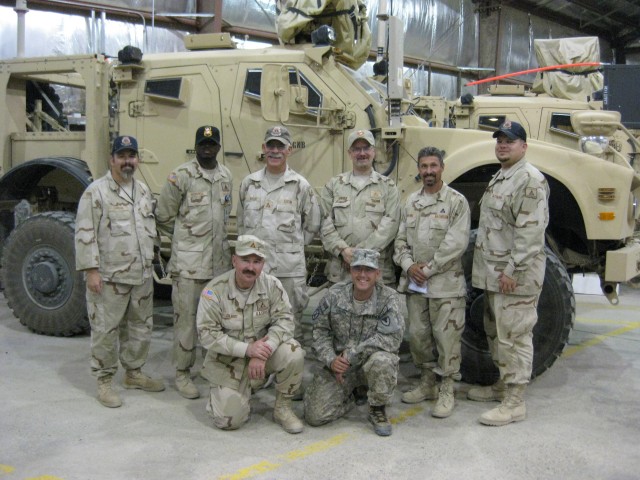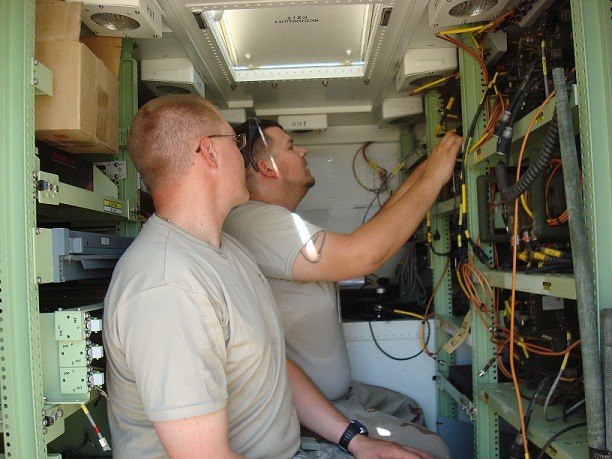Regional Command North in northern Afghanistan is commanded by a German officer (as part of NATO's International Security Assistance Force) and, until early this year, there was no real United States Army presence in the region.
That changed when the 1st Brigade Combat Team, 10th Mountain Division (Light Infantry) rolled into RC-North in March 2010, occupying three primary forward operating bases: Camp Spann on the edge of Mazar-e-Sharif in Balkh province, FOB Griffin on the western edge of RC-North in Faryab province, and FOB Kunduz in the east-central region of RC-North in Kunduz Province.
Supporting the BCT is the 1/10 Mountain Brigade Logistics Support Team which is compromised of 21 personnel consisting of the BLST chief, a logistics management specialist from Army Sustainment Command, plus logistics assistance representatives from CECOM, TACOM and Joint Munitions Command. Specialized contractors supporting Blue Force Tracker systems, Digital Combat Ground Systems, Biometric Identification Collection systems and intelligence tracking systems help tie the systems together to provide a common operating picture for the BCT. The BLST also provides area coverage for all US facilities in RC-North, currently thirteen units and growing.
The primary FOB in RC-North is Camp Mike Spann, which is the BLST's 'home base.' Camp Spann is located approximately 18 miles from Mazar-e-Sharif, the fourth largest city in Afghanistan. The Camp is named for Johnny Micheal "Mike" Spann, a paramilitary operations officer for the Central Intelligence Agency, and the first American casualty of war in Afghanistan. He died during the "riot of Qala-i-Jangi" prison, two hours after interrogating John Walker Lindh, the "American Taliban".
Although the FOB has been established for quite some time, prior to the 1BCT's arrival, its primary purpose was to house Operational Mentor and Liaison Teams from Germany, Switzerland and Croatia. FOB Kunduz and Camp Griffin were established only one year ago, and were initially established as Combat Outposts (COPs), which have since grown into FOBs.
With the influx of 3,000 personnel with and in support of the 1st BCT, the majority of what now sits on these three FOBs had to be built from scratch. Our BLST played a significant role in establishing the life support and communications architecture that supports all of these locations, as well as the ever-increasing number of COPs which have developed over the past five months.
In order to provide first-class logistical support to the region, the BLST had to establish its own operational footprint. Within 48 hours of arrival on the ground, construction of the BLST facility began with a general-purpose modular tent from the Early Entry Logistics Support Element System (EELS) - complete with a plywood platform floor.
From the very beginning, all of the members of the BLST have worked together as a team to accomplish a common goal. Once the facility was erected, it had to be powered, which is where Power and Environmental LAR Gary Dygert's handiwork came into play. Within a matter of hours, with assistance from other members of the team, Gary had power and air flowing to the new BLST facility, as well as to the facilities utilized by the 401st Logistics Task Force. His work was critical not only in establishing power, but also with regard to getting communications established for the BSLT and the LTF as the servers for the Multi-Media Communications System (MMCS) - which allow the BLST and other members in the Army Materiel Command community to communicate - were housed in the LTF shelter.
As the FOBs matured, the BCT headquarters outgrew the tactical operations center that it had fallen in on, and moved into a new two-story TOC facility in the middle of Camp Mike Spann. Without the dedication of CECOM Information Technology/Radio LAR Chris Efflandt and Tobyhanna TOC Field Service Representative Jaime Martinez, this task would have taken several days to complete. Because of their technical expertise and initiative, the TOC move was completed in 48 hours with all communications packages working in unison.
Although most of the members of this team did not know each other prior to this deployment, the bond that they share is as strong as that of brothers, complete with the occasional sibling rivalry. Harmless practical jokes are commonplace when there is a little down-time, but when it is time to get down to business, these guys are true professionals.
While many of the members of the BLST are veterans at deploying, for some, this is their first deployment. CECOM Standard Army Management Information System LAR Tony Jackson had this to say about his experience, "Camp Mike Spann (2010) is my first deployment assignment as a CECOM STAMIS LAR. I did not know what to expect prior to arriving in Spann. Being a part of the 1/10 BLST has been a great experience for me. Regardless of sleeping in an Alaskan tent, or working out of an EELs tent, I believe it is what you make out of your deployment which determines your experience.
"Before arriving at Camp Mike Spann I was a bit hesitant on the concept of convoying," Jackson said. "However, after 'FOB-hopping' a couple of times you understand that it's not only you going on convoys, but a group of Soldiers as well.
"This deployment has been terribly fun for me and I hope that I get to do this again with the same caliber BLST team I am with today", Jackson said. "Working in conjunction with the unit Sustainment Automation Support Management Office, we were able to set up communications and maintain all the STAMIS systems in FOBs Kunduz, Griffin, Spann, Dehdadi I, and Dehdadi II."
The expertise on this team is "world class." Although not organic to Army units, 307th Signal Battalion at Camp Marmal has employed a USC-60 terminal and data package to provide communications throughout RC-North. CECOM IT/Switch LAR Louis Durran has been the subject-matter expert in emplacing this system from start to finish, a project that has taken four months to complete. His talents resulted in the successful implementation of the system and enabled several Soldiers to learn from his experiences.
This is just one example of the quality of the LARs on the team. Collectively, the team has provided over 1,300 man-hours of training to over 520 Soldiers, and has saved the government over $645,000 through various cost avoidance measures.
Although the conditions on Camp Spann are austere, they are nothing compared to life in FOB Kunduz. CECOM Sensor LAR Greg Janeczek understands this well as the AN/TPQ-36 Firefinder Radar for RC-North is operating there. He spent the better part of four months at FOB Kunduz as the only LAR on the FOB. He was truly the "AMC's Face to the Field" at FOB Kunduz.
In addition to establishing the radar site and resolving critical force-protection issues, Greg was routinely called upon to assist in matters that were outside of his lane, including technical issues with power generation equipment and tactical wheeled vehicles. For quite some time, he had Power and Engineering LAR Gary Dygert and TACOM Automotive LAR Tracy Worrell on speed-dial.
According to Janeczek, it is the little things that make the difference. "Being the only LAR on the FOB, I was asked to assist in areas that I would not normally engage, as they were more TACOM-related issues than CECOM issues. However, at such a remote and austere FOB, I could not in good conscience tell a Soldier 'No.'"
Janeczek recalled one event far out of his usual range. "I successfully assisted the unit in obtaining a replacement tail light equipped with the Driver Viewer Enhancement (DVE) camera," he said. "These [stock] numbers are not in the Oshkosh repair manuals issued to the Soldiers, as the DVE system is an aftermarket system that is added after the vehicle leaves the Oshkosh manufacturing facility."
He recently returned to the hustle and bustle of Camp Spann for some well-deserved R&R.
As small arms maintenance is one of the top priorities for the BCT, TACOM Armament LAR Larry Church did his share of traveling as well. Over one two-day period, the BCT experienced two serious weapons malfunctions, damaging both weapons and causing minor injuries to a Soldier. With no time to waste, Church was launched to FOB Kunduz with the 10th Brigade Support Battalion Armament Technician, Chief Warrant Officer 2 Nick Walker. While the cause of the malfunction to one of the weapons could not be definitively determined, the malfunction on the second weapon was apparently the result of improper adjustment. Over the course of the next several days, Church and Walker gave a series of classes on how to properly adjust the weapon. To further increase the gunners' confidence, firing drills were performed in a controlled environment, enabling the gunners to get a better feel for the weapon's capabilities. The training package was also taken to Camp Griffin and provided to the Soldiers there to reinforce the same standards. Since the training was concluded, we have not experienced any malfunctions resulting from improper adjustments to that weapon.
In addition to providing on-the-spot expertise and training, Church was also instrumental in the de-processing and service of 116 M2 .50 caliber machine guns and 72 MK19 grenade launchers. In an example of the Materiel Enterprise at work for troops in the field, the weapons are on temporary loan to the BCT from Anniston Army Depot for the duration of the deployment.
The conditions in RC-North are very different from what most LARs are accustomed to. Although many LARs convoy on occasion to provide emergency support, the members of the 1/10 MTN BLST convoy routinely in support of daily mission requirements. Since there is no air support on Camp Spann, the team members must convoy one hour to the nearest air terminal at Camp Marmal in order to fly to their next destination.
The members of the BLST work together, eat together, and sleep together. While living accommodations in other areas of Afghanistan may consist of containerized housing units, complete with bathroom and shower, in the North Country we live ten men to a tent. Although the living quarters are tight, it has provided an opportunity that many other LARs do not get. Living so closely with one another, friendships have been forged that will survive well beyond this deployment.
As we approach the six-month mark in the deployment, many of the team members are looking forward to one last convoy to Camp Marmal as they make their journey back to their loved ones in the States.
Wherever their journey takes them, I am sure that they will always remember good-ol' Camp Mike Spann.
- This article was prepared with help from Chris Efflandt (CECOM IT/Radio LAR), Tony Jackson (CECOM STAMIS LAR) and Greg Janeczek (CECOM Sensor LAR).
(Editor's Note: Brigade Logistics Support Teams are an element of Army Sustainment Command. Comprised of experienced, expert technicians and logisticians from across Army Materiel Command, the BLST brings to bear the might of the Materiel Enterprise and places it "On the Line" with expeditionary forces.)








Social Sharing